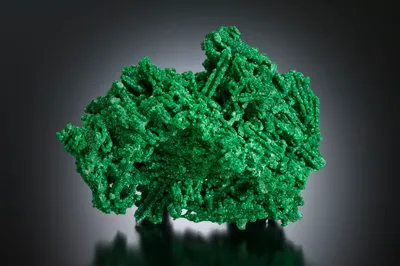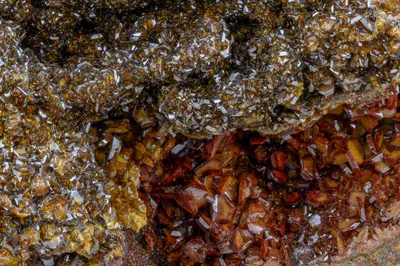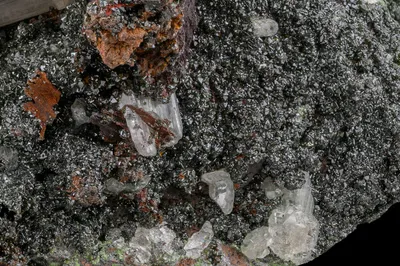Mineral Species
Segnitite
Type Locality
No
Composition
PbFe3+3H(AsO4)(AsO3OH)(OH)6
Crystal System
Trigonal
Status at Tsumeb
Believed valid
Abundance
Extremely rare
Distribution
Second oxidation zone
Paragenesis
Supergene
Entry Number
Species; TSNB313
General Notes
Segnitite is a member of the dussertite group of minerals in the alunite supergroup. It is the Fe3+ analogue of philipsbornite and forms a series with beudantite in which segnitite is the sulphate-deficient end-member (Birch et al. 1992; Back 2022). Segnitite and beudantite are visually indistinguishable and of sufficient structural similarity that a compositional analysis, ideally quantitative, is required for certain identification.
Gebhard (1999) provided the first published report of segnitite from Tsumeb. He stated that:
"… segnitite was … discovered on samples from the collection of the late John Innes. Segnitite occurs as brown crystals up to 5 mm with duftite. In typical fashion for this locality, it can be noted that segnitite from Tsumeb is unrivalled by any other locality."
His photograph of segnitite (Gebhard 1999; page 168) is incorrectly captioned, however, with duftite mis-labelled as "… needles of olivenite" and arsentsumebite mis-labelled as "… clusters of duftite". Regrettably, Gebhard does not indicate how the segnitite was verified.
Three specimens from the same occurrence (also originating from the John Innes collection) have been analysed and all have been found to be beudantite (i.e., with significant sulphate content). Specimens from the Pinch Collection (MGMH 2020.7.721) and Feinglos Collection (MGMH 2022.4.6025L) were analysed by EDS and found to contain significant sulphur (Frank Keutsch, pers. comm. to M. Southwood, October 2023). A specimen in the Southwood Collection (MS 2016.064) was analysed by WDS (University of Queensland, Australia) and returned an average composition (from 12 analyses) of 1.1 S : 0.9 As (APFU). The possibility that both segnitite and beudantite are present on these specimens – perhaps as zoned crystals (?) – cannot be completely ruled out at this stage but there is no doubt that beudantite is the overwhelmingly dominant species. Further work is required.
Tsumeb is one of only two segnitite localities named in the Handbook of Mineralogy (Anthony et al. 2001-2005; https://www.handbookofmineralogy.org/pdfs/segnitite.pdf; accessed February 2023) but the fact that associated minerals (for Tsumeb) are given as olivenite and duftite implies that the information in the Handbook is based on Gebhard (1999).
In describing the new species gallobeudantite, Jambor et al. (1996) noted that some zones in crystals of gallobeudantite have a composition corresponding to an un-named Ga analogue of segnitite.
Similarly, a "… Ge-rich segnitite as pseudo-cubic crystals" associated with bartelkeite and an "… unknown Fe3+Ge1+ oxide" were offered for sale by Joy Désor (ex. Armin Schöler) in December 2022 (www.e-rocks.com ; accessed December 2022). All mineral phases had been verified by SEM-EDS.
Associated Minerals
arsentsumebite; bartelkeite; beudantite; duftite; gallobeudantite; pyromorphite



